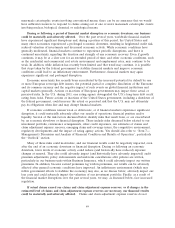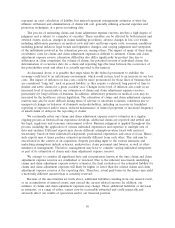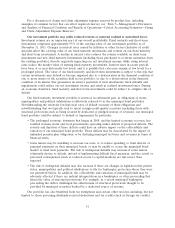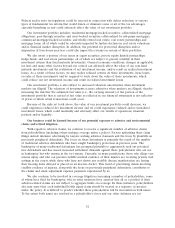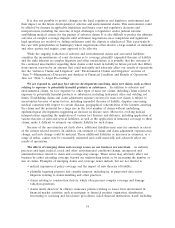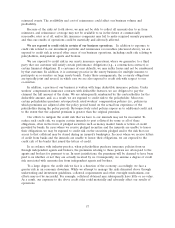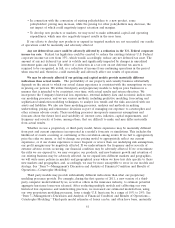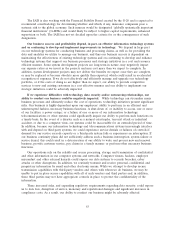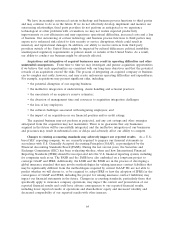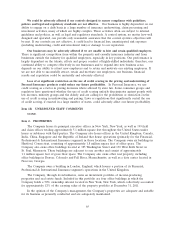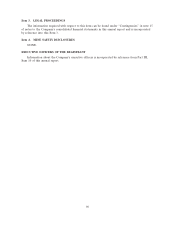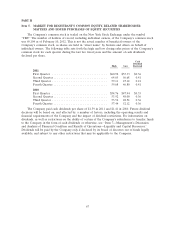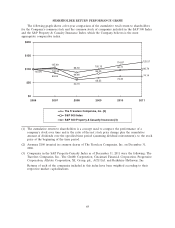Travelers 2011 Annual Report Download - page 70
Download and view the complete annual report
Please find page 70 of the 2011 Travelers annual report below. You can navigate through the pages in the report by either clicking on the pages listed below, or by using the keyword search tool below to find specific information within the annual report.Within the United States, our businesses are heavily regulated by the states in which we conduct
business, including licensing and supervision, and changes in regulation may reduce our profitability
and limit our growth. These regulatory systems are generally designed to protect the interests of
policyholders, and not necessarily the interests of insurers, their shareholders and other investors. For
example, to protect policyholders whose insurance company becomes financially insolvent, guaranty
funds have been established in all 50 states to pay the covered claims of policyholders in the event of
an insolvency of an insurer, subject to applicable state limits. The funding of guaranty funds is provided
through assessments levied against remaining insurers in the marketplace. As a result, the insolvency of
one or more insurance companies could result in additional assessments levied against us.
These regulatory systems also address authorization for lines of business, policyholders’ surplus
requirements, limitations on the types and amounts of certain investments, underwriting limitations,
transactions with affiliates, dividend limitations, changes in control, premium rates and a variety of
other financial and non-financial components of an insurer’s business.
In recent years, the state insurance regulatory framework has come under increased scrutiny, and
some state legislatures have considered or enacted laws that may alter or increase state authority to
regulate insurance companies and insurance holding companies. Further, the NAIC and state insurance
regulators continually reexamine existing laws and regulations, specifically focusing on modifications to
holding company regulations, interpretations of existing laws and the development of new laws and
regulations. In a time of financial uncertainty or a prolonged economic downturn or otherwise,
regulators may choose to adopt more restrictive insurance laws and regulations. For example, insurance
regulators may choose to restrict the ability of insurance subsidiaries to make payments to their parent
companies or reject rate increases due to the economic environment. The state insurance regulators
may also increase the statutory capital requirements for our insurance subsidiaries.
In addition, state tax laws that specifically impact the insurance industry, such as premium taxes or
other taxes, may be enacted or changed by states to raise revenues.
State regulations or laws that are adopted or amended may be more restrictive than current laws
or regulations and may result in lower revenues and/or higher costs of compliance and thus could
materially and adversely affect our results of operations and limit our growth.
Changes in federal regulation could impose significant burdens on us and otherwise adversely
impact our results. While the U.S. federal government has not historically regulated the insurance
business, in 2010 the Dodd-Frank Wall Street Reform and Consumer Protection Act (the Dodd-Frank
Act) established a Federal Insurance Office within the U.S. Department of the Treasury. The Federal
Insurance Office has limited regulatory authority and is empowered to gather data and information
regarding the insurance industry and insurers, including conducting a study for submission to the U.S.
Congress on how to modernize and improve insurance regulation in the U.S. Further, the Dodd-Frank
Act gives the Federal Reserve supervisory authority over a number of nonbank financial services
holding companies, including insurance companies, if they are designated by a two-thirds vote of a
Financial Stability Oversight Council (the Council) as ‘‘systemically important financial institutions’’
(SIFI). While recent rules proposed by the Council support our view that we will not be designated as
a SIFI as defined in the Dodd-Frank Act, it is possible that the Council may change its rules or
interpretations in the future and conclude that we are a SIFI. If we were designated as ‘‘systemically
important,’’ the Federal Reserve’s supervisory authority could include the ability to impose heightened
financial regulation and could impact requirements regarding our capital, liquidity and leverage as well
as our business and investment conduct. As a result of the foregoing, the Dodd-Frank Act, or other
additional federal regulation that is adopted in the future, could impose significant burdens on us,
including impacting the ways in which we conduct our business, increasing compliance costs and
duplicating state regulation, and could result in a competitive disadvantage, particularly relative to
smaller insurers that may not be subject to the same level of regulation.
58



